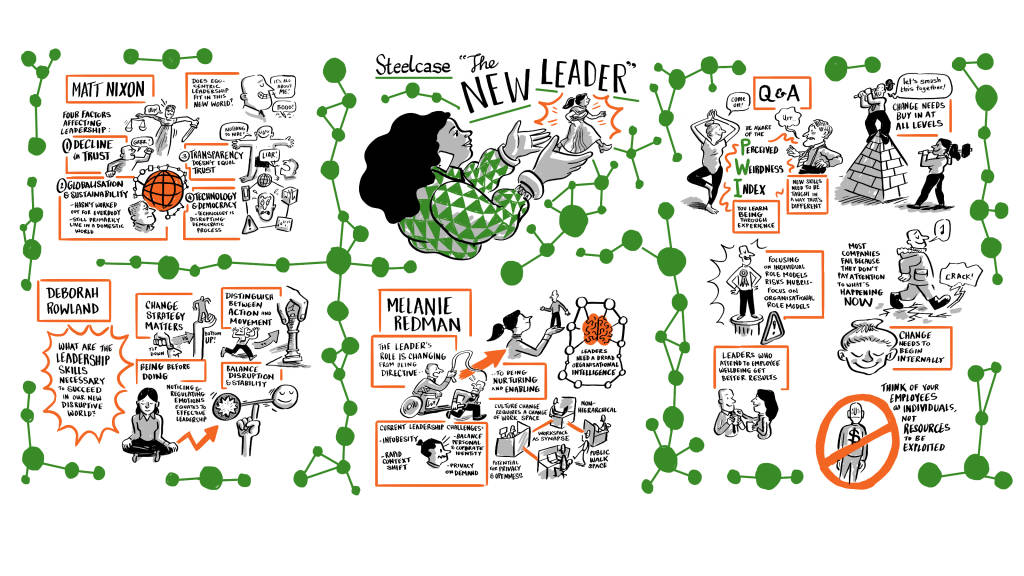Leadership Experts: Leaders Must Change
An expert panel in the Steelcase London WorkLife Center focused on the new ways in which leaders have to work.
“To improve is to change, so to be perfect is to have changed often,” the quote often prescribed to Winston Churchill may have been borrowed by Churchill himself, but it aptly describes how leaders are being required to react to the complex global environment in which we find ourselves today.
Organizations are evolving from complicated business structures to ecosystems where each piece is interdependent upon the other. Disruptive political and economic changes are forcing organizations into uncertain futures. While at the same time, technology is constantly altering the playing field. Small startups are breaking through seemingly overnight and artificial intelligence is both a wild-eyed opportunity and a threat to quickly even the competitive playing field.
These factors are driving leaders of global organizations to change how they work. Recently, Steelcase hosted “The New Leader,” an expert panel at its London WorkLife Center to address these changes. Matt Nixon, founder of The Disraeli Group, a leadership consulting firm, Deborah Rowland, a thought-leader on leading change, and Melanie Redman, senior researcher for WorkSpace Futures at Steelcase joined the discussion.
CONVERGING FACTORS
Nixon gave his view on four factors converging right now to make leadership more difficult than ever.
- Declining Trust – There is an increasing trust gap between the world’s leaders and those who are led. There’s a strong feeling across the world that elites just don’t understand the challenges real people face.
- Globalization – Globalization can create real change. But, not everyone is engaged. Nixon quotes The New Politics of Immigration and the End of Settler Societies which says 97 percent of people work in the country and culture in which they were born. That creates a disconnect when trying to globalize an organization.
- Transparency – There’s a tension between the desire for transparency and the need for privacy creating another pinch point when trying to develop trust.
- Technology and Democracy – Throughout time, technology has always changed the way we work. But, the certainty of disruption now is certainly high. Organizations can be disrupted directly by political changes or economic competitors. Nixon also noted the importance for leaders to actively use technology to communicate and to build their reputation.

NEW WAYS TO LEAD
Rowland reminded the audience that while human beings have not changed much, the environment has changed dramatically. She offered suggestions on how leaders can adapt and focus on new ways to lead.
Change Strategy Matters – How leaders approach change matters a great deal, Rowland says. You can no longer impose change upon people. They must have confidence in the outcome based on how they are being led.
Being Before Doing – Recent research relayed by Rowland finds the more leaders are in command of their inner selves, and are able to identify and regulate their emotions, the more inspiring they are as a leader. To lead big change, leaders must work on their inner state first.
Staying Present – The world is full of distractions. Leaders who want to be successful leading change, Rowland says, need to focus on the here and now. They can not be anxious about tomorrow or worrying about what happened yesterday. Everything leaders can change is happening at the present moment.
SUPPORTING THE NEW LEADER
Because the new way of leading requires so many different kinds of work modes, today’s leadership environment should consist of an ecosystem of spaces designed to support a variety of workstyles, says Redman. Researchers at Steelcase developed a concept based on three design principles.
Nurture the Individual – Environments that can help executives manage stress and promote wellbeing can also enhance the cognitive process.
Enable Transitions – Physical spaces should support executive’s needs to constantly shift from one topic to the next by helping them get into flow faster.
Space as Synapse – Leadership spaces can help facilitate better connections between people and information. At the same time, they can provide remote executives with a virtual presence more similar to those leaders who are physically present in the space.
Recently, the Steelcase executive team moved into its new Leadership Community based on the design principles Redman presented. Like other Steelcase workplaces, it’s considered a behavioral prototype – a fully built-out environment where concepts can be tested and evaluated in actual use over time. To see photos and more information about the concepts already being explored visit The New Leader in the most recent issue of 360 Magazine.


